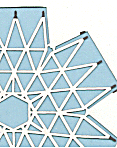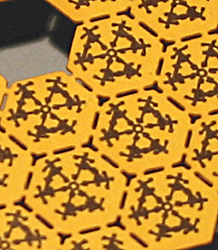The Keck Telescope
|
99-cent 3D-Printable files are available for some components of this kit.Major sections making up most of this model, are available as fully-3D-printed items. |
To get an idea of the scale of this giant Earth-based telescope, notice the tiny railings surrounding the central hexagon and its jutting platforms. They're a little taller than waist-height. The twin Keck Telescopes, on Mauna Kea in Hawaii, are indeed huge. They each have four times the light-collecting area of the 200-inch Hale Telescope on Mount Palomar, which, until Keck, was the world's premier astronomical telescope.
Builders of the massive Hale had reached the limits of their technology. A telescope of Hale's design having four times its light collecting area would have had about eight times its mass — technically and financially an impossibility to construct. But the Keck Telescopes are not massive behemoths of the old school. Their use of computers, and highly advanced optical, mechanical, and systems designs have introduced a whole new paradigm.
This Space Craft SCIENCE KIT shows exactly what that new paradigm is. As you build the structure, you see first hand how strong the lightweight structure becomes by virtue of its design. You see exactly how all 36 lightweight mirror segments are floated by computer-controlled actuators which maintain the overall mirror's perfect shape. And you can see exactly where the sensors are that let the computer do that. You see how stable its mounting system is (Keck uses a computer-controlled azimuth-elevation mounting system,
 a departure from the equatorial systems of older telescopes, with their asymmetric load bearing). All these concepts become perfectly clear, right at your fingertips. But let's go back to those waist-high railings. The scale of this model is close to the model-railroad "N" guage, so it isn't hard to find tiny plastic human figures or vehicles which, when displayed with the Keck model, illustrate its startling size.
a departure from the equatorial systems of older telescopes, with their asymmetric load bearing). All these concepts become perfectly clear, right at your fingertips. But let's go back to those waist-high railings. The scale of this model is close to the model-railroad "N" guage, so it isn't hard to find tiny plastic human figures or vehicles which, when displayed with the Keck model, illustrate its startling size.
The bottom-most of the three model parts that go to make up the "mirror cell" (that is, the bottom trusswork structure of the telescope), is shown in the small image at right. Even though that section of the telescope appears very complicated when you look at a finished model, or the telescope itself, the model kit mirror cell is only made of three laser-cut model parts! You might be able to recognize how this part shown on the right folds and fits into the mirror cell structure.

The two flat platforms, one on either side of the telescope, are called Nasmyth platforms, and the kit's fact sheet explains their purpose, as it explains everything else about the Keck Telescopes. In the small image at left, there's a close-up of part of a blue Nasmyth platform. Those dots are actually holes clear through the card stock, put there, of course, by the laser we use. You can actually see through the model's Nasmyth platforms, as if looking through a screen. The purpose of this is to replicate the feel of the Keck Telescopes' actual Nasmyth platforms, which are made of perforated steel. The model's holes are not scale size - our laser isn't that good. But it does replicate the feel. This is representative of how all the parts in this model bring together surprisingly accurate scale models of the world's new premier telescopes.
 Just one more detail to tout. Here's an image, on the right, that shows part of the Keck model's primary mirror, which, in the telescope, is made up of 36 individual segments. The top side of this model part is reflective silver foil. The bottom looks like this. In the model piece, each segment joins its neighbor with two tiny links. Those two links are the locations spanned by position sensors in the actual mirrors. The yellow color of the model part simulates the yellow color of the "ZERODUR" glass ceramic of which the mirror segments are made. And the black markings represent the support structures, called "whiffle trees," which are glued to the actual mirror segments. Information in the kit explains these markings in detail.
Just one more detail to tout. Here's an image, on the right, that shows part of the Keck model's primary mirror, which, in the telescope, is made up of 36 individual segments. The top side of this model part is reflective silver foil. The bottom looks like this. In the model piece, each segment joins its neighbor with two tiny links. Those two links are the locations spanned by position sensors in the actual mirrors. The yellow color of the model part simulates the yellow color of the "ZERODUR" glass ceramic of which the mirror segments are made. And the black markings represent the support structures, called "whiffle trees," which are glued to the actual mirror segments. Information in the kit explains these markings in detail.
References to the Hale 200-inch telescope here, and in the fact sheet text, are not meant to belittle the Hale, which is still very much a first-class research tool. An excellent description of the Hale telescope and its history can be found in "The Perfect Machine; Building the Palomar Telescope" by Ronald Florence, Harper Perennial 1994. This book also provides a good background for appreciating the new paradigm represented by the Keck Telescopes and their contemporaries.
The Keck Telescope kit has 34 laser-cut parts. Assembled model is about 5.75 inches (14.5 cm) overall. Scale is approximately 1/170.
View the Keck Kit's Fact Sheet.
Keck Telescope SCIENCE KIT Price:
Only the model parts are shipped. Assembly Instructions, Fact Sheet, and Presentation Guide are accessible here on the website. Free shipping within the U.S., Canada, and Mexico. For other countries, $10.50 is added to the order total for shipping and handling. See the "How to Order" button below.
Space Craft SCIENCE KITs are designed and made in the U.S.A. using state-of-the-art processes and the highest quality recycled materials.
Also available from the Shapeways SCI Shop, in the form of three 3D printed items. Mix or match them with parts from your laser-cut Keck Telescope SCI Kit; they're all the same scale.
| | SCI HOME PAGE | CATALOG | HOW TO ORDER | |
PAGE UPDATED 2021 MARCH 20
